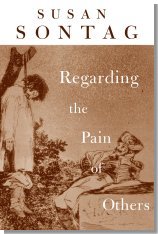 |
 |
 |
 |
 |
 |
|
|
|
|
|
|
|
 Regarding the Pain Of Others BACK ________________________________________________________ |
||
 |
In June 1938 Virginia Woolf published Three Guineas, her brave, unwelcomed reflections on the roots of war. Written during the preceding two years, while she and most of her intimates and fellow writers were rapt by the advancing fascist insurrection in Spain, the book was couched as the very tardy reply to a letter from an eminent lawyer in London who had asked, "How in your opinion are we to prevent war?" Woolf begins by observing tartly that a truthful dialogue between them may not be possible. For though they belong to the same class, "the educated class, a vast gulf separates them: the lawyer is a man and she is a woman. Men make war. Men (most men) like war, since for men there is "some glory, some necessity, some satisfaction in fighting" that women (most women) do not feel or enjoy. What does an educated -- read: privileged, well-off -- woman like her know of war? Can her recoil from its allure be like his? Let us test this "difficulty of communication," Woolf proposes, by looking together at images of war. The images are some of the photographs the beleaguered Spanish government has been sending out twice a week; she footnotes: "Written in the winter of 1936-37." Let's see, Woolf writes, "whether when we look at the same photographs we feel the same things." She continues: This morning's collection contains the photograph of what might be a man's body, or a woman's; it is so mutilated that it might, on the other hand, be the body of a pig. But those certainly are dead children, and that undoubtedly is the section of a house. A bomb has torn open the side; there is still a bird-cage hanging in what was presumably the sitting room . . . The quickest, driest way to convey the inner commotion caused by these photographs is by noting that one can't always make out the subject, so thorough is the ruin of flesh and stone they depict. And from there Woolf speeds to her conclusion. We do have the same responses, "however different the education, the traditions behind us," she says to the lawyer. Her evidence: both "we" -- here women are the "we" -- and you might well respond in the same words. You, Sir, call them "horror and disgust." We also can them horror and disgust . . . War, you say, is an abomination; a barbarity; war must, be stopped at whatever cost. And we echo your words. War is an abomination; a barbarity; war must be stopped. Who believes today that war can be abolished? No one, not even pacifists. We hope only (so far in vain) to stop genocide and to bring to justice those who commit gross violations of the laws of war (for there are laws of war, to which combatants should be held), and to be able to stop specific wars by imposing negotiated alternatives to armed conflict. It may be hard to credit the desperate resolve produced by the aftershock of the First World War, when the realization of the ruin Europe had brought on itself took hold. Condemning war as such did not seem so futile or irrelevant in the wake of the paper fantasies of the Kellogg-Briand Pact of 1928, in which fifteen leading nations, including the United States, France, Great Britain, Germany, Italy, and Japan, solemnly renounced war as an instrument of national policy; even Freud and Einstein were drawn into the debate with a public exchange of letters in 1932 titled "Why War?" Woolf's Three Guineas, appearing toward the close of nearly two decades of plangent denunciations of war, offered the originality (which made this the least well received of all her books) of focusing on what was regarded as too obvious or inapposite to be mentioned, much less brooded over: that war is a man's game -- that the killing machine has a gender, and it is male. Nevertheless, the temerity of Woolf's version of "Why War?" does not make her revulsion against war any less conventional in its rhetoric, in its summations, rich in repeated phrases. And photographs of the victims of war are themselves a species of rhetoric. They reiterate. They simplify. They agitate. They create the illusion of consensus. Invoking this hypothetical shared experience ("we are seeing with you the same dead bodies, the same ruined houses"), Woolf professes to believe that the shock of such pictures cannot fail to unite people of good will. Does it? To be sure, Woolf and the unnamed addressee of this book-length letter are not any two people. Although they are separated by the age-old affinities of feeling and practice of their respective sexes, as Woolf has reminded him, the lawyer is hardly a standard-issue bellicose male. His antiwar opinions are no more in doubt than are hers. After all, his question was not, What are your thoughts about preventing war? It was, How in your opinion are we to prevent war? It is this "we" that Woolf challenges at the start of her book: she refuses to allow her interlocutor to take a "we" for granted. But into this "we," after the pages devoted to the feminist point, she then subsides. No "we" should be taken for granted when the subject is looking at other people's pain. |
 |
 |
||
HOME | PRIZE FOR TRANSLATION | SUSAN SONTAG | ABOUT | EVENTS | DONATE
© 2010 Estate of Susan Sontag. All Rights Reserved.